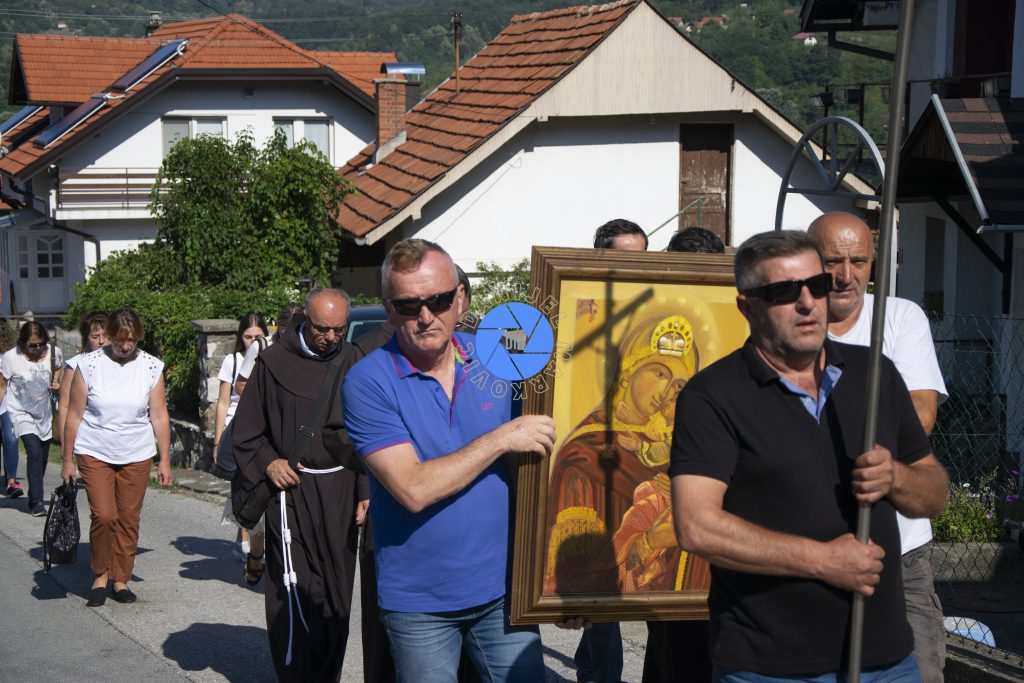Source:
http://gradovrh.com/?p=160Translation courtesy of Google...
Pilgrimage to Gradovrh 2022
On the feast of Our Lady of the Angels, which is celebrated on August 2, a pilgrimage to Gradovrh takes place. The pilgrimage begins in the branch church in Solina, from where one goes on foot to Gradovrh, carrying a cross, a picture of Our Lady of Gradovrh and praying the rosary. This pilgrimage began on the 300th anniversary of the departure of the friars and believers from the area of Soli, precisely in 1988 before the onslaught of the Ottoman torturers. The Šokci of Vojvodina at that time, specifically from Bač and its surroundings, brought the original image of Our Lady of Gradovrško-Bačka, which is kept today in the Bač monastery.

The procession goes from the church in Solina through the Solina settlement, partly through the forest and the former Maglašević castle to the friar's fields, which were returned to the property of the Franciscan monastery in 2008. After the arrival, the faithful have the opportunity for a holy confession, followed by a holy mass. This year there were many believers, and there were also pilgrims from the parish of Srca Marijina, Foča near Derventa with their parish priest Fr. Franjo Dalibor Stjepanović. On their way out, the faithful sang, which you can see and hear in the video at the end of the article.
History of Gradovrh
Gradovrh was an old Bosnian town on the Solina river. In the last century, the walls of the fortress were visible. The Franciscans from the monastery of St. Marije from Gornja Tuzla when it was destroyed (1535). There, Ivan Maglašević and his son Pavao (with the sultan's permission) built a church and monastery for them in 1541. At one time, the famous image of the Mother of God Zvornik was kept in the church.
Bishop Baličević found a monastery and a church in Gornja Tuzla in 1600, and in the monastery there were 15 Franciscans (10 priests, 3 clerics and 2 lay brothers). They served 400 Catholic families with 1,600 believers. The church was very visited (both Orthodox and Muslims come) and the people gave it gifts, so it was not bothered even by the thieves who had robbed it. (The councilor of the provincial administration /definitor/ Friar Jure Neretljanin writes to Rome in 1623 that Our Lady performed a great miracle over the bandits who killed twelve /out of fourteen/ friars one night). At that time, the monastery in Gradovrh served five parishes: Gradovrh, Dragunja, Bijela, Korjenita and Brk. Tuzla Monastery of St. Petra had only three parishes: Tuzla, Pojalje and Gračanica.
Friar Petar Zlojutrić, bishop of Sofia, was buried in the monastery in Gradovrh in 1623. Friar Pavao Rovinjanin, a visitor, describes how he visited Gradovrh in 1640 and found the monastery doors chained with iron, and the monastery was small (like half a church), while in the spacious and beautiful the church was guarded by a painting of Our Lady from Zvornik (of great artistic value). In 1674, Bishop Nikola Ogramić-Olovčić came to Gradovrh and found the monastery deserted (because he was over-indebted with 70 Turkish creditors to whom he owed 13,000 ducats!!!). The monastery had 40 members, 10 children and 6 servants. The Donja Tuzla monastery also had a debt of 4,000 ducats. The monasteries spent a lot of money to bribe the Turkish courts to free them from the attack of the Patriarch of Pec, who demanded a church tax from the Catholics and wanted to subject them to his rule. The Turks, on the other hand, threatened to turn the Gradovrh monastery into a mosque if the friars did not pay the debt. Tuzla's monasteries and the Catholic population suffered heavily during the Vienna Wars (1683 – 1699), when people emigrated en masse from these regions, and then the rest of the Catholics disappeared among the Muslims and the Orthodox. According to Bishop Olovčić, in 1674 there was only one church, one parish house and 1,200 Catholics in Tuzla, and in Gradovrho the monastery was permanently closed and a friar came to it on holidays to say mass and immediately ran away to avoid being caught by the creditors. The parish had 1,400 souls. It was even worse in the parishes served by this monastery: Brka has neither a church nor a house, but there are 1,962 Catholics, in Korjenica (Bijeljino Polje) there is no church but only a parish house with 1,418 Catholics. There is no church in the parish of Bijela, which has 995 Catholics, nor in Dragunja,
In Gradovrh, on the 22nd of VIII. In 1682, the guard Fr. Bernardin was killed with a dagger, and Fr. Luka, the parish priest, was roasted alive, while the gatekeeper, Fr. Tadija Soilo, was impaled in the monastery. Finally, in 1688, after troubles, famine and plague, the Franciscans left the monastery in Gradovrh and moved to Bač, where they had a parish. The monastery in Bač was called Gradovrški until 1705, but later it had to be called Bački. The friars left the monastery of St. Peter in Donja Tuzla in 1690, leaving a guard and one priest, but when the Croats reached Tuzla in December and destroyed the city, these two also had to flee across the Sava with 3,000 believers to Cernik, and then to Šarengrad. True, the Franciscans soon rebuilt the monastery in Donja Tuzla, but in 1697 they left it again and went to Šarengrad, building a monastery in Vocin. Wars and persecutions have taken their toll.
Friar Pavao Dragičević wrote in 1742 that there were bare traces of a church, next to which was the monastery of Gradovrh, in a hilly, completely neglected place. And since then, he is no longer mentioned in Bosnia except in the stories of rare old men and in the names of some friary fields.



